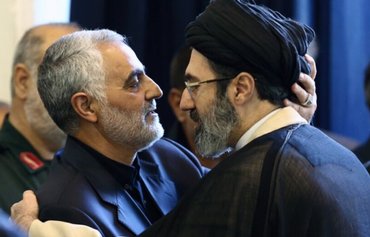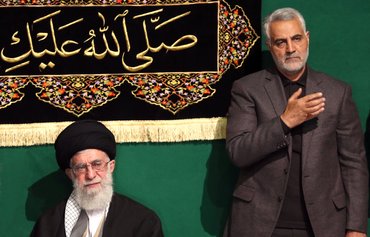With the recent publication of a leaked report detailing a lengthy meeting between Iranian leader Ali Khamenei and senior officials, IranWire reveals the turmoil roiling the highest echelons of Iran's regime.
The March 19 report, which the expatriate news outlet says it obtained from "sources in Iran", documents a four-hour meeting held in Tehran on January 3.
Held on the anniversary of the killing of Islamic Revolutionary Guard Corps Quds Force (IRGC-QF) commander Qassem Soleimani, the meeting brought 58 senior IRGC and intelligence officials together to discuss developments with Khamenei.
According to the leaked document, the meeting was focused on the anti-regime protests in Iran, which started after the death in September of 22-year-old Mahsa Amini while in custody of the morality police.
![Security forces, mostly members of the IRGC and Basij, have suppressed protests in Iran since September. [Iran International]](/cnmi_am/images/2023/03/24/41320-Iran-protests-Basij-600_384.jpg)
Security forces, mostly members of the IRGC and Basij, have suppressed protests in Iran since September. [Iran International]
![Some 5,000 clerics in Iran's Basij forces have derobed since the start of the protests in September. [Independent Persian]](/cnmi_am/images/2023/03/24/41310-Iran-Basij-clerics-600_384.jpg)
Some 5,000 clerics in Iran's Basij forces have derobed since the start of the protests in September. [Independent Persian]
A number of high-ranking IRGC commanders reportedly expressed their frustration over the ongoing protests -- then in their fourth month -- and warned about the Islamic Republic's future.
Their remarks expose the growing rift within the ranks of the IRGC, their lack of commitment to the regime's principles, and the regime's apparent inability to quell the popular uprising.
Lack of faith in regime
The account of the meeting indicates a shortage in financial and human resources, with most of the IRGC commanders present asking for a larger budget for their forces.
It also shows a lack of faith in the system, its ideology and regulations.
Mahmoud Mohammadi-Shahroudi -- who directs the Clerics and Seminary Students' Basij force, which is overseen by the IRGC-aligned paramilitary Basij Resistance Forces -- elaborated on the issue in his remarks.
Some 5,000 clerics have left the Basij force, and numerous clerics have "derobed" (meaning they have taken off the symbolic turban and robe Shia clerics wear, as a sign of defecting from the clergy), he said.
A large number of non-cleric Basij forces also have left the force, he added.
Abdollah Haji-Sadeghi, Khamenei's representative in the IRGC, was quoted as saying that the IRGC forces "are not in the same situation as last year", as some have lost their faith in the system.
"Our information shows that there are rifts among the IRGC forces, which require mitigation," he said, according to the leaked document.
"We are not talking about one or two people here; we are discussing a collection of armed forces with over 600,000 members" in different groups, he said.
Solidarity with the public
Ehsan Khorshidi, an IRGC official in Alborz province, said goods were stolen from an IRGC warehouse in the province, which led many to think insiders were to blame, the document said.
Upon further investigation, however, it appeared that a number of personnel in charge of transporting the items had distributed them among impoverished members of the public in Karaj, he said.
"We don't know what to do," Khorshidi was quoted as saying, adding that "the fact that IRGC forces are consoling the public is not a small issue".
"These people have stolen from the IRGC, but they have given the stolen items to needy people who do not even have bread on their dinner table," he said.
"What are we to do if they distribute weapons among the public next?"
Khorshidi said "at least six individuals" had contacted him on the day of the meeting, requesting the release of family members detained during the protests, but there is a limit to the number of people commanders could release.
Attack on Khamenei's residence
The leaked document also included a report on three foiled attacks on "certain targets in Tehran", including an artillery attack on Khamenei's residence.
Gholamali Rashid, commander of the IRGC's Khatam-al Anbiya base, said the plots were planned by "disobedient elements", without elaborating on who might have been responsible.
The plots, which stemmed from "terrorist thoughts", were foiled, he said.
Separately, a few IRGC commanders said forces under their command had disobeyed orders and refused to suppress the protesters, as they had been directed to do.
In many cases, security, IRGC and Basij forces have reportedly dispersed when protesters have persisted.
Five days before the meeting, on December 30, senior IRGC commander Hamid Abazari said a number of high-ranking clerics and senior IRGC commanders had criticised the regime's treatment of protesters, IranWire reported.
Aftermath of the meeting
Khamenei's stance and rhetoric over the protests appeared to have softened in a speech he made January 4, possibly as a result of the remarks that were made one day earlier at his meeting with IRGC officials, analysts noted.
In an earlier speech delivered November 26, Khamenei used harsh words to describe the protesters, taking a powerful stance against them and accusing them of treason and of "being the principal enemy".
On January 4, his tone was markedly different, IranWire said.
Several decisions reached after the meeting include exempting all Basij ranks from paying taxes in Iran's new budget, and allocating a larger part of the budget to the IRGC, intelligence forces and the military compared to last year.
On January 7, Iran's overall commander of the police force, IRGC official Hossein Ashtari, was replaced by Ahmad-Reza Radan, another former IRGC commander.
IranWire also attributed Khamenei's February order to release thousands of imprisoned protesters to the January 3 meeting.
The leaked document has given further credence to what many inside and outside Iran can see already -- that the regime is at an inflection point, and is beginning to succumb to the pressure of the protests.
Facing resilient Iranians and the power of domestic dissent, Tehran's damage control appears to get shakier by the day, as the people threaten the very pillars of the regime, including compulsory coverage for women.

![Iranians protesting in Tehran last October. [AFP]](/cnmi_am/images/2023/03/24/41336-32l23yq-highres-600_384.jpg)






